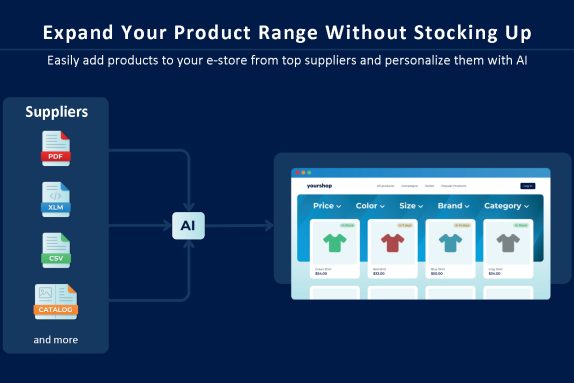We began exploring and experimenting with Lumav’s AI capabilities as soon as the first sustainable models became available, looking for ways to apply them in e-commerce. Today, in addition to e-store development and business process automation, we provide a range of AI solutions for our clients, develop our own AI products, and increasingly use AI automation in our internal operations.
Our Experience with AI tools
After the initial wave of excitement, a more sober phase set in. Generative AI offers entertaining possibilities and can produce fairly solid summaries, but the error rate is still too high to integrate it blindly into business processes. AI is like a wild mustang — full of energy and potential, but to harness its strength for pulling the cart, you first need to tame it.
Our conclusion so far is that universal, one-size-fits-all (and free) tools rarely deliver a competitive advantage, even if there are a few good finds. A business must either invest time in setting them up or work with an expert to configure a solution tailored to its needs.
We also remain cautious about overly broad, “give us access to everything and we’ll do it all” solutions from young startups. It’s worth checking whether they can provide reliable input — and whether you’re ready to entrust your company’s data to an untested consultancy.
Success with AI depends on choosing a partner who understands your existing business and technology processes.
As practitioners of multiple AI projects, our advice for successfully adopting AI is a little different from the usual:
1. Start by solving one urgent, narrow problem in an internal process or online store with the help of AI automation. Every company has a few low-hanging fruits — use them to demonstrate immediate value, gauge your team’s readiness for change, and secure buy-in for the next phase.
Only after that:
2. Research case studies, and get up to speed on the different possibilities with the help of a partner or or an AI training course.
3. Involve different departments and map:
a) pain points in existing processes, and
b) “wish-list” ideas employees would pursue if they had more time.
4. Build an AI roadmap, prioritize developments, and start implementation.
Below are some areas where we’ve supported clients — both for their first steps and as part of a broader AI audit or to-do list.
1. Enriching Product Data & SEO
This is where we’ve experimented the most and achieved the greatest progress. Early results were mixed in quality, and a human should remain in the loop before moving to full automation. Still, AI as an off-the-shelf tool is valuable for structuring product information according to best practices and for suggesting what extra data might benefit a given category.
Using multiple inputs and combining models already produces solid results, though a subtle “AI accent” may remain.
Products not fully online can’t be sold — improving product data enrichment is often the best investment. (In our previous post, we discussed external assortments as a way to test new products and scale e-commerce with lower risk.) Automating product data enrichment means integrating ERP, e-commerce, and PIM solutions, and deciding where AI belongs in that chain.
Better product information naturally boosts SEO, but AI can also create high-quality content for search engines: alt texts, meta descriptions, and other SEO elements can outperform standard Magento module outputs.
2. Data Analysis: Turning Everyone into a Researcher
AI enables businesses to dramatically improve customer insights and get a clearer picture of what’s happening in their e-commerce environment. For initial situational awareness, AI can process data types that previously required heavy manual effort:
- Qualitative data – e.g., customer feedback or questions, helping surface new ideas and understand human experience.
- Quantitative data – numbers from large datasets, perfect for statistics or an executive “helicopter view.”
For example, Net Promoter Score (NPS) blends both data types (“On a scale of 1–10, how likely are you to recommend our store, and why?”). AI can score the text automatically, making feedback easier to collect. Summarizing thousands of customer messages and separating the signal from the noise no longer requires a dedicated analyst.
You don’t need deep expertise in data science or advanced statistical tools to create reports. AI can add structure to text or extract narratives from numbers.
3. Smart Search & Personalization
At a recent Lumav seminar on e-store search, the phrase “…and that endless work with search…” drew a collective sigh from participants. Indeed, expectations for good search results vary widely across industries, personas, and even individual customers. Sometimes the shopper wants one thing, while the merchant wants to showcase another.
Smart search projects are among the most complex AI initiatives. Quality results don’t come from a simple off-the-shelf model; you need context-specific training. Every AI search query has a cost, so optimization is essential. At Lumav, we’ve delivered near-perfect answers to very complex queries, with costs still well below a human operator’s time.
Alternative product suggestions are another popular feature, but often solvable with a one-time module (e.g., matching dimensions, impact, or size). AI-based recommendations become worthwhile when a wider context matters (e.g., weather, informal customer input) or when richer outputs are required.
4. Knowledge Management
Questions such as “Why were these decisions made?”, “What should we keep in mind when starting a new project?”, “What services could we offer this client?”, or “Which projects need more resources?” require synthesizing information from multiple sources — much of it often stored only in people’s heads. When employees leave, so does their know-how.
If decisions or actions are digitally documented (emails, wikis, retros, etc.), systems can be integrated and AI used as a knowledge base, reducing the risk of repeating old mistakes.
There are, however, limits:
- Access rights – who can see which information.
- Relevance – whether later updates have invalidated earlier data.
When used “as is,” AI can give managers quick overviews for decision-making and browsing history. Questions that might otherwise require a week of research or multiple meetings can be answered in seconds.
5. Automating Internal Processes
There are now plenty of AI-powered tools promising dramatic productivity gains. It’s worth testing and integrating the best into business workflows — or developing custom solutions tailored to your needs.
Examples include: scheduling and documenting meetings, drafting email templates, creating tasks in project management or time-tracking tools, preparing summaries, testing, and more. Freed-up time can then be invested in building client relationships or driving sales.
The feeling of “I suddenly have so much free time — what now?” will set new expectations for future employees. AI isn’t taking jobs away; it’s changing the nature of work and enabling greater efficiency. Translators become AI editors, developers become AI engineers, data entry specialists become analysts. Adaptive, curious employees have nothing to fear — only opportunities to grow.
Lumav’s Investments in AI tools
Lumav continues to investigate and to invest in AI workflow automation and AI for ecommerce.
Currently in development is a tool for managers and business analysts that reduces the workload of data entry specialists, technical analysts, and developers by enabling cross-platform information queries across company systems.
We are also exploring how AI can support marketing data analysis, especially for large-catalog e-commerce stores.
Finally, we’re enhancing employee productivity with AI-generated alerts, reports, and other supportive tools.
Conclusion about AI automations
We see many well-designed (often small) businesses where a few people — or even a single founder — achieve the same output as large teams, thanks to carefully planned processes and AI automation. At the same time, we encounter well-intentioned solutions that employees simply never adopt.
Artificial intelligence can create a real competitive advantage, but there is a world of difference between adopting AI and successfully adopting it. The market is full of new products, services, and vendors promising to solve problems, and you can collect small wins along the way. Still, it’s essential to look past marketing hype and focus on measurable results.
For sustainable success, combine your business expertise with AI, adapting it to fit existing workflows. We’re here to help — let’s talk about how AI can support your business.




















